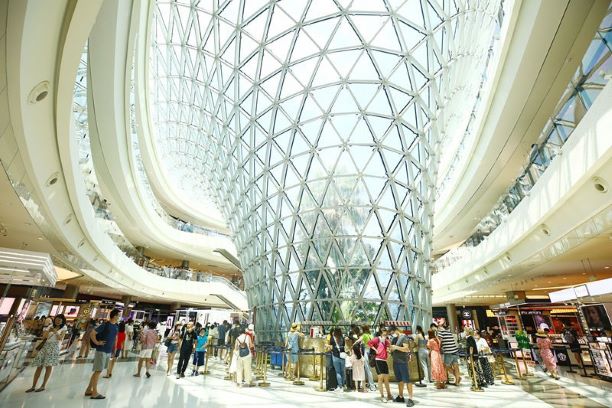New duty-free policy unveiled to stimulate consumption in South China’s Hainan
By Huang Xiaohui, People’s Daily
Consumers shop at an international duty-free store in Sanya on June 30. Photo by Chen Wenwu/People’s Daily Online
A newly updated duty-free policy was officially implemented in South China’s island province Hainan starting from July 1, one month after a master plan was released aiming to build the province into a globally influential high-level free trade port.
Since the pilot implementation of duty-free shopping policy in 2011, it has so far been updated seven times, with the newest adjustment considered as the strongest one.
Besides increasing the annual tax-free shopping quota in Hainan from 30,000 yuan ($4,272) to 100,000 yuan per person each year, the policy has also expanded the categories of duty-free goods from 38 to 45, with electronic products, honey, tea and several other products added to the duty-free list.
Driven by the new duty-free policy of Hainan, Xiao Meng, a resident in Guangzhou, south China’s Guangdong Province, flew to Haikou, capital city of Hainan, to hit the duty-free stores.
“As the previous tax-free limit of 8,000 yuan for a single product has been lifted, I can now buy a 17,000-yuan luxury watch without paying taxes which would total over 4,000 yuan under the previous policy,” said Xiao.
In fact, electronic products such as mobile phones and laptops have become very popular in the duty-free stores thanks to the recently updated policy.
“For fear that customers may snap up mobile phones, the store has set up a rule that each customer could only purchase one set each time,” said a staff member from a duty-free store of Haikou Riyue Plaza.
For example, the iPhone 11 Pro Max (512GB) is priced at 10,210 yuan in the duty-free stores of Hainan, 2,489 yuan lower than that on Apple’s official website in China.
Meanwhile, the iPhone 11 Pro Max (256GB) is priced at 8,625 yuan in Hainan, 2,274 yuan lower than that on the official website of Apple’s online store for China and about 1,200 yuan lower than that in Hong Kong.
The iPhone 11 (128GB), the cheapest model in Hainan’s duty-free stores, charges 5,105 yuan, while it is sold at 5,999 yuan on Apple’s official website.
The newly adjusted policy will greatly release policy dividends in the development of the Hainan free trade port, first of its kind in China.
Statistics suggest that 3.84 million people spent 13.6 billion yuan at duty-free stores in Hainan last year, while 483,600 people and 986 million yuan in 2011.
It is expected that the sales of offshore duty-free products will reach over 66.1 billion yuan by 2023, generating a profit of 13.23 billion yuan for Hainan and greatly stimulating the local economic development, according to study by Guotai Junan Securities, one of the largest investment banks and securities companies in China.
The province aims to introduce cross-border e-commerce platforms first and then expand online operation to brick-and-mortar shops, according to Cao Ying, an official with the office of Hainan free trade port, adding that online cross-border platforms now run over 1,000 kinds of products, which meets the basic needs of the consumers.
To improve consumers’ shopping experience, Hainan will continue to improve the consumption and tourism market, in a bid to build the province into a global hub for tourism and consumption.
It is speeding up the construction of an international duty-free mall with a total investment of over 10 billion yuan in Haikou.
Once completed, the mall will cover an area of 200,000 square meters, three times that of the one in Sanya. It will provide a whole-chain experience for consumers, including food, accommodation, traveling, shopping and entertainment and serve as a landmark project of building Hainan into an international hub for consumption and tourism.
Zhou Ting, director of Yaok Institute, a professional high-end lifestyle and luxury research and advisory body, believes that the implementation of the new duty-free policy is of major significance for constructing the Hainan international tourism island.
Zhou suggested that Hainan open up even wider and form a high-quality consumer market for tourists as well as improve services and develop recreational activities, so as to truly become an international tourism and consumption center.













